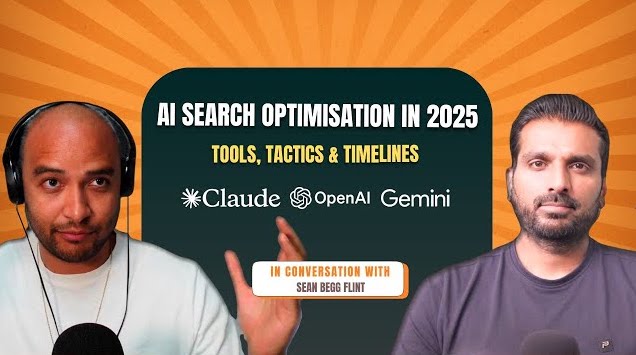Tired of chasing leads through cold calls and endless LinkedIn DMs? Why not flip the script and let prospects come to you with search engine optimization (SEO)?
Recruitment SEO helps your agency rank higher in search engines like Google, and get consistently recommended by LLMs like ChatGPT.
This means when hiring managers and job seekers are actively searching for recruitment services or job opportunities, it’s your website that pops out instead of competitors.
In this guide, I’ll break down the steps to build a recruitment SEO strategy that brings you a steady stream of high-value clients and candidates.
Why is SEO Important for Recruiters?
Many recruitment agencies rely on traditional lead generation methods like cold outreach, networking events, and paid ads.
The problem is, those tactics are either expensive or time consuming (or both). Not to mention, they often hit people when they’re not actively looking for a recruiter.
You end up wasting time and money chasing leads, instead of attracting the ones already searching for your services.
SEO flips that model. It helps your recruitment agency:
- Save money in the long run: Unlike PPC or LinkedIn ads, organic traffic doesn’t stop flowing the second you stop spending.
- Build authority and trust: Ranking high in Google and ChatGPT signals credibility to both clients and candidates.
- Attract the right audience: By targeting the right keywords, you filter for people actively searching for your services or job postings. No more cold calling—when your phone rings, it’s from warm leads who actually want what you offer.
One of our clients, a PA recruitment agency called Oriel Partners, said this:
Position Digital has transformed our recruitment agency. We used to rely on cold calling for new business but now clients come to us. We never have to cold call again!

Olivia Coughtrie, Co-founder & Director at Oriel Partners
Follow the exact methods we use to help recruitment agencies like Oriel Partners generate consistent inbound leads without relying on cold calling or paid ads.
Get access to our recruitment SEO masterclass here.
The Core Pillars of Recruitment SEO Strategy
SEO for recruitment requires a different approach than other sectors.
Unlike most industries, recruitment agencies serve two very different user groups: employers who need to fill roles and job seekers looking for their next opportunity.
That means your SEO strategy needs to account for both audiences:
Dual Keyword Research
Keyword research is the foundation of your SEO strategy.
When you know exactly what your audience types into Google, you’ll be able to create content that answers their questions and serves their needs.
Since you’re targeting two different user groups, you’ll need to split your keyword list into two categories:
- Employer-focused keywords: Queries like “recruitment agency london” or “executive search firm new york.”
- Candidate-focused keywords: Phrases such as “marketing jobs” or “sales roles near me.”
Another thing to consider is location-based keywords. Recruitment is often tied to geography – employers want local talent, and job seekers want opportunities in their city or region.
So, incorporate the name of the country, city, or region where your agency operates or where a job is based directly into your keywords.
Content Planning & Mapping
Once you’ve nailed down your keyword lists, the next step is turning them into a content plan. Think of this as your roadmap – every keyword should link to a specific page or piece of content on your site.
It’s also important to map your content to each buyer persona (hiring managers and job seekers) and their specific journey.
Oriel Partners does this really well by splitting their site into two clear pathways:
- Looking to hire: Aimed at companies looking to hire talent. Content types include recruitment service pages, resources (job description templates and salary surveys), and blog posts on hiring best practices.
- Looking for a job: Aimed at job seekers looking for new opportunities. Content types include job listings, resources (CV advice and templates), and educational content on career tips.

By mapping out content this way, you avoid confusion, capture the right traffic, and make sure both sides of your business pipeline are covered.
On-Page Optimization
On-page optimization is about making sure that each content piece follows search engine guidelines and provides the best experience possible for users.
The goal is to rank your pages higher in Google for your target keywords, attract highly-qualified leads, and eventually convert them into clients.
Key areas to focus on include:
- Page speed: Nobody likes a slow website. Fast loading time keeps users engaged and is a direct ranking factor for Google.
- Mobile-friendliness: Around 89% of job seekers use their smartphone to search for job ads. So, your pages need to be responsive and easy to navigate on mobile devices.
- Title tags and meta descriptions: Optimize these with your target keywords and make them compelling enough to drive clicks.
- SEO-friendly headlines: Structure your content with clear headings (H1, H2, H3) that include relevant keywords and make pages scannable.
- Keyword placement: Naturally weave keywords into the first paragraph, headings, and throughout the content without overstuffing.
- Job posting structured data: If you want your job listings to appear in search results, you’ll need to add the JobPosting schema markup to your job pages.
- Calls-to-action (CTAs): Every page should guide users to the next step, whether that’s contacting you for recruitment services or applying for a role.
While technical optimization is important, don’t forget about content quality. Every piece of content you publish should answer user intent and provide genuinely helpful insights.
In fact, this is a key factor that contributes to Oriel Partners’ success:
The content team at Position Digital are so talented. They really know the recruitment sector and effortlessly produce such insightful and high-quality content which attracts top clients and candidates.

Olivia Coughtrie, Co-founder & Director at Oriel Partners
Offsite SEO Signals
SEO doesn’t stop at your own website. You also need to think about off-page SEO signals, such as:
- High-quality backlinks. When trusted websites link to your agency, it signals to search engines that you’re a credible and authoritative source. So, they’ll be more likely to push your site up the search rankings. If you’re looking for a starting point, read our guide on how to get your first 100 backlinks.
- Positive brand mentions. Even without a link, when your agency’s name appears consistently across the web, search and AI engines will take notice. In fact, according to an Ahrefs study, branded web mentions are the leading factor for AI Overview inclusion.

These offsite signals not only boost your credibility in the eyes of search engines and LLMs, but also help potential clients and candidates discover your recruitment agency.
Here are some third-party platforms that you, as a recruiter, should be present:
- Google Business Profile: Make sure your profile is set up, optimized with relevant keywords, and updated with the right contact details. This is essential for local searches like “recruitment agency near me.”
- Job boards and aggregators: Posting jobs on platforms like Indeed, Reed, and LinkedIn Jobs increases your visibility in Google for Jobs, which often appears at the very top of search results.
- Social media: Active engagement on LinkedIn, X (formerly Twitter), and even TikTok can increase your brand visibility and build trust with both employers and candidates.
- Review sites: Positive reviews on Google and platforms like Glassdoor can boost both your rankings and your reputation. Encourage satisfied clients and candidates to leave feedback.
- Forums and communities: Industry-specific forums, Quora, or Reddit threads can be great places to share insights, answer questions, and subtly raise awareness of your expertise.
If you’re not sure where to begin, it’s always easier to work with an SEO agency that offers targeted digital PR services like Position Digital.
Here’s what Olivia Coughtrie, Co-founder & Director at Oriel Partners, had to say:
Position Digital has landed us press coverage in top HR and recruitment magazines. We are now regarded as one of the top recruiters in our niche because of our online visibility.

Olivia Coughtrie, Co-founder & Director at Oriel Partners
Generative Engine Optimization
Optimizing solely for traditional search engines like Google is no longer enough.
Some of your potential clients and candidates are asking AI chatbots directly for recruitment service recommendations or relevant job postings.
So, your agency needs to constantly appear in AI Mode summaries, as well as ChatGPT and Perplexity answers.
This can be done by building an entity that AI models can recognize, trust, and eventually, recommend.
Here’s how:
- Engineer brand associations: Tie your agency to a specific brand positioning. For example: instead of just “recruitment agency”, go for “personal assistant recruitment agency in London.”
- Repeat this messaging throughout your site: Your homepage, About page, service pages, as well as blog posts should all reinforce the same positioning. This helps AI systems understand what your agency does, who it serves, and where it operates.
- Ensure consistent positioning on the wider web: Beyond your own website, make sure your unique brand positioning is consistent across the web. This includes your Google Business Profile, LinkedIn page, review sites, industry directories, and press releases.
If you want to dive deeper into the topic, check out our guide on how to rank in Google’s AI Mode. While the article talks specifically about AI Mode, the core principles apply to other LLMs as well.
How to Attract High-Value Clients
I’ve helped numerous recruitment agencies turn their websites into lead-generation machines.
Here are the key SEO tactics that consistently attract qualified clients who are ready to hire.
1. Find Out What Hiring Managers Are Searching
First of all, you need to know exactly what your ideal clients type when looking for recruitment services.
There are several sources you can get keyword ideas from:
- Your existing clients: Ask them how they found you online or what they would search if they were looking for an agency today.
- Other recruitment sites: Use keyword research tools like Ahrefs and Semrush to analyze the exact keywords your competitors rank for.
- Google’s SERP features: Enter your main keyword in Google and study the Autocomplete suggestions, People Also Ask boxes, and the Related Searches section at the bottom of the page. These features reveal the real queries employers are typing in and the follow-up questions they want answered.

After compiling a list of potential keywords, use your favorite keyword research tool to evaluate their potential and also expand on them.
Focus on:
- Search volume: How many people search for this term each month? Higher search volume means higher user demand.
- Keyword difficulty: Check how difficult it will be to rank. Some keywords are dominated by big agencies, so it’s often smarter to target long-tail phrases where you can realistically compete.
- Location: Prioritize keywords that include the city, region, or country you serve, such as “personal assistant recruitment agency London” and “how to hire engineers in Saudi Arabia.”
- Related keywords: Most tools will suggest variations and long-tail queries you may not have thought of. These are gold for creating supporting content and capturing employers searching in different ways.

Once you figure out which keywords to target, organize them based on search intent. This way, you can create content that meets prospects at every stage of their buying journey.
- Informational intent: Broad queries where employers are searching for information, such as “how to hire an admin” or “benefits of using an executive search firm.” These are perfect for blog posts and guides.
- Commercial intent: Keywords that show research with the intent to buy, like “best IT recruitment agencies in London.” Suitable content types include comparison articles and listicles.
- Transactional intent: High-intent searches such as “recruitment agency near me” or “hire executive recruiter New York.” These belong on service pages.
2. Create Content That Satisfies User Intent
Not every employer is searching for the same thing. Some are casually exploring their options, while others urgently need a recruiter to fill a role.
The key is to create content that speaks to your target audience at every stage of their journey.
Here’s how I usually approach it:
Build awareness with educational content
Educational content shows your expertise and positions your agency as a trusted hiring partner. It also helps you rank for informational intent keywords that capture employers earlier in their buying journey.
Examples:
- Blog posts and guides answering common employer questions, such as “How to reduce time-to-hire in finance roles” and “Signs it’s time to use a recruitment agency.”
- Salary surveys and industry reports that employers can benchmark against, like “2025 Marketing Salary Survey London.”
- Downloadable resources like job description templates, interview question checklists, or cost-per-hire calculators.
- Thought-leadership pieces on hiring trends or the future of recruitment.

Position your agency as the solution
When employers are actively searching for recruitment services, they want to know who’s the best fit.
This is where you create content that highlights your credibility, differentiates your offering, and proves your results.
Examples:
- Sector-specific landing pages, such as “Tech Recruitment Specialists in California.”
- Comparison articles like “The 10 best recruitment agencies for finance roles in the UK” (with your agency prominently featured).
- Case studies showing measurable results, like reducing time-to-hire by 30% or filling executive roles in record time.

Convert leads with transactional pages
For employers who are ready to take action, your content should make it as easy as possible to get in touch. These pages should be conversion-focused, persuasive, and keyword-optimized.
For example, you can publish service pages optimized for each role you specialize and each location you serve, such as:
- Personal assistant recruitment agency in London
- Finance recruitment agency in Manchester
- Executive search firm in New York
Each page should include:
- Clear, benefit-driven, headlines that speak to employer pain points
- Proof of results, including client testimonials and reviews
- A FAQ section that answers common employer questions
- Strong calls-to-action like “Book a consultation today” or “Request a proposal”

3. Improve Site Structure With Internal Linking
Your content doesn’t sit in isolation – it’s part of a bigger ecosystem. Internal linking is how you connect those pieces together so both search engines and hiring managers can easily navigate your site.
When done right, internal links:
- Distribute authority (“link equity”) across your site and signal which pages are most important to Google.
- Make navigation effortless for hiring managers, keeping them on your site longer and moving them closer to enquiry forms.
Here’s how to put it into practice:
- Cross-link between relevant articles: Your guide to hiring a temporary employee should link to “Benefits or hiring a temp worker”, “Common interview questions for temporary roles”, and other relevant content pieces.
- Link blog posts to service pages: If you write a guide on “How to reduce time-to-hire,” link it to your “Executive Search Services” page. This turns informational traffic into potential leads.
- Use descriptive anchor text: Instead of “click here,” use phrases like “our IT recruitment services in London” to give Google and users more context.
- Add key links to navigation, footers, and FAQs: Ensure your most important service pages are linked in your top menu, footer area, and even FAQ sections. This makes them easy to find and signals to Google that these pages matter most.

Pro tip: Create a simple spreadsheet that maps which pages should link to which. This way, you avoid overlinking and ensure that every important page gets a steady flow of internal links.
4. Optimize for Local Search Results
Recruitment is often hyper-local. Employers don’t just want a recruiter – they want one in their city, who knows the market and has access to local talent.
That’s why local SEO is essential. It helps you attract potential clients looking to hire talent in your area.
Follow these tips to strengthen your local presence:
- Optimize your Google Business Profile: Add accurate contact details, target keywords in your business description, upload photos of your office, and post regular updates. This helps you appear in the local “map pack” for searches like “recruitment agency near me.”
- Improve your Google Business Profile reviews: Encourage happy clients and candidates to leave positive Google reviews and ratings to boost social proof.
- Create localized service pages: Create pages for each city or region you serve, e.g. “Sales recruitment agency Manchester” or “Executive search London.” Optimize each page with local keywords, testimonials, and relevant case studies.
- Add local signals across your site: Display your office address, phone number, and opening hours on your site. Embed a Google Map on your contact page and location-specific service pages to reinforce geographic relevance.

5. Ensure Flawless Technical SEO
Technical SEO (or tech SEO) is about making sure search engines can crawl, index, and understand your site without friction, while also giving users a seamless experience.
Why it matters:
- Googlebot and AI bots won’t rank pages they can’t access or crawl properly
- Slow, broken, or poorly structured sites frustrate users and increase bounce rates
- Strong technical SEO builds the foundation for every other part of your SEO strategy
Use tools like Screaming Frog or Sitebulb to:
- Identify broken links: Find 404 errors and fix them or redirect to relevant pages.
- Check crawlability: Ensure your robots.txt file isn’t blocking search engines and AI bots from crawling important pages.
- Evaluate site structure: Help Google understand your site structure by making sure your XML sitemap is accurate and submitted to Google Search Console.
- Review meta tags: Spot missing, duplicate, or poorly optimized title tags and meta descriptions.
- Audit site speed: Identify slow-loading pages and images that need compression.
- Test mobile-friendliness: Confirm that pages load quickly and display correctly across devices.
Pro tip: Run a full technical SEO audit at least quarterly. Think of it as a health check for your site – small fixes here often lead to big gains in visibility and conversions.
6. Optimize for AI-Generated Answers
To increase your chance of being included in AI responses, focus on securing mentions in platforms that AI models usually pull data from.
Based on various AI SEO studies, those include:
- Wikipedia
- Forums like Reddit and Quora
- Editorial and affiliate sites like Forbes
- Review sites like G2
- Social media platforms like LinkedIn
Besides building a strong offsite presence, it’s equally important to optimize your content in a way that AI engines can easily parse and extract:
- Clear headings: Break down content with descriptive H1, H2, and H3 tags that mirror the questions your clients are likely asking. For example: “How do I hire a personal assistant in London?”
- BLUF (Bottom Line Up Front): Start sections with a concise, direct answer before diving into detail. This matches the way AI engines summarize content.
- Bullet points: Present lists, processes, and comparisons in bullet format so they’re easily scannable and extractable.
- FAQs: Add a dedicated FAQ section to key service and blog pages. Write the questions exactly as a client or candidate would ask them, and provide clear, concise answers.
Check out how we optimized one of Oriel Partners’ blog posts that led to AI Overview citations for 17 keywords.

How to Attract Quality Candidates and Job Seekers
Winning top clients is only half the battle. If you want to bring consistent results for employers, you also need a steady stream of quality candidates.
Here’s how recruitment SEO helps you attract job seekers who are actively looking for their next opportunity.
1. Offer Helpful Resources for Candidates
Candidates are more likely to trust an agency that gives them value upfront.
Create genuinely helpful resources that answer their most common questions and support their career growth.
Examples:
- Blog posts with interview tips and CV advice.
- Salary guides to help candidates benchmark their skills.
- Downloadable CV and cover letters templates.

These resources build authority and generate organic traffic from candidate-focused queries like “how to write a CV for marketing jobs” or “graduate salaries in London 2025.”
2. Optimize Job Postings
Job posting optimization is about making your roles more discoverable in Google for Jobs and search engine results pages (SERPs).
When done well, it ensures candidates see your openings before they see competitors.
Here’s how to optimize your job postings:
- Research what candidates are typing: Use tools like Ahrefs, Semrush, or even Google’s Autocomplete to find the exact terms job seekers use. Focus on candidate-focused keywords like “marketing jobs London” rather than recruiter jargon like “Marketing Associate II.”
- Optimize title tags and meta descriptions: Your job posting’s metadata should contain the main keyword you’re targeting. It should also be compelling and persuasive enough to drive clicks from search results.
- Write keyword-rich job descriptions: Naturally include relevant terms (skills, role type, location) in your job descriptions. However, avoid keyword stuffing, as it will harm both SEO and candidate experience.
- Prioritize user experience: Make sure your job pages load quickly on both desktop and mobile devices. Also, include a clear “Apply Now” button to make it easy for candidates to apply.
- Keep your job listings up-to-date: Expired or outdated listings frustrate candidates and hurt SEO performance. Remove closed roles promptly, refresh active postings regularly, and make sure the publish dates are current so Google for Jobs continues to prioritize them.
3. Leverage Third-Party Job Boards
Posting your roles on third-party job boards and aggregators can increase reach and improve the chances of being featured in Google for Jobs, which often appears at the very top of search results.
Here’s how to maximize results:
- Post on popular job platforms: Sites like Indeed, Reed, Glassdoor, and LinkedIn have high domain authority and are frequently crawled by Google for Jobs. Posting there increases the odds of your roles being surfaced.
- Use niche job boards: Industry-specific boards (e.g. Dice for tech, eFinancialCareers for finance) attract highly qualified candidates with the exact skills your clients need.
- Link back to your site: Always include a direct link to the original posting on your website. This drives referral traffic and strengthens your recruitment website SEO.

Attract Consistent Inbound Leads With Position Digital
SEO helps your recruitment agency attract high-value clients, bring in quality candidates, and build a sustainable pipeline of leads, all without relying on cold calls or endless LinkedIn outreach.
At Position Digital, we specialize in helping recruitment agencies turn their websites into powerful lead-generation machines.
Ready to attract more clients and candidates through the power of SEO? Let’s chat.
In case you want to explore other lead generation strategies beyond SEO, check out these tips from 13 recruitment marketing experts.






